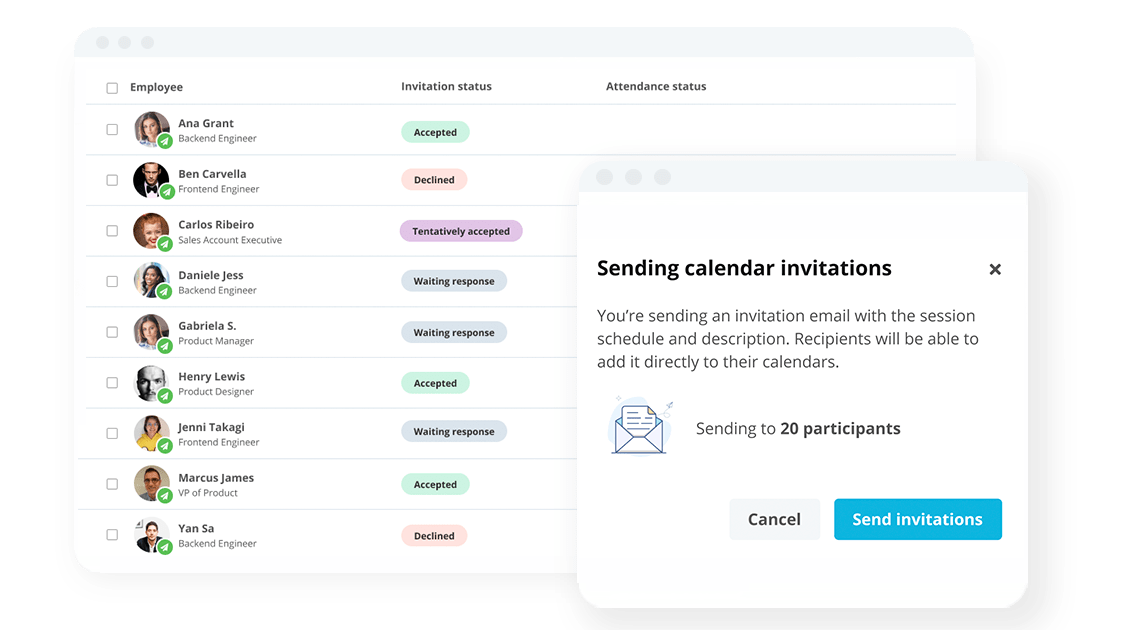
Give the Right Training at the Right Time
Simplify your staff development with centralised training management.
Future-proof Teams With PersonioOn-the-job training: 7 reasons to embrace it today

In this article, we aim to inform you about all the benefits of on-the-job training, how it helps your employees and the advantages it offers your business.
Key Facts
On-the-job training focuses on practical, hands-on experience to learn new skills.
Employees can learn faster and build trust between their peers before officially starting a position.
Businesses can benefit from employees who are productive right out of training.
What Is On-the-Job Training?
On-the-job training is when new employees learn applicable skills for their role while in the workplace. It’s a practical training method focused on a hands-on approach in a live or simulated training environment, typically under the guidance of a supervisor or mentor.
7 On-the-Job Training Advantages
On-the-job training offers several advantages to you and your employees…
1. Expand Training With Real Experience
On-the-job training promotes faster learning of company tools and processes, particularly when supplementing off-the-job training methods and as part of a training programme or training needs analysis.
Employees pick up essential skills more quickly when given a visual demonstration of their applicability within the workplace and retain information better with hands-on experience.
2. Easily Applicable
Training someone on the job is easier to implement and provides more direct results than a collection or scattering of different training methods. Instead, employees can refer back to old training modules or ask a supervisor. Additionally, practical experience under the guidance of a senior employee can help new hires reduce mistakes before going into a live environment.
3. Saves Money and Time
On-the-job instruction helps mitigate typical onboarding costs such as training rooms, reference material, presenters and travel. Employees have easy access to all necessary materials while supervisors provide them with expert guidance. And once their training is complete, they can immediately transition into live work.
4. Increases Productivity
Employees retaining more information and having hands-on experience with company processes means they can become productive faster after transitioning into real work situations. Additionally, the adjustment period is shortened by their practical experience and easy access to reference material or experienced help from a peer.
5. Increases Employee Retention
When employees aren’t clear on the expectations and responsibilities, it can cause stress that affects job performance and retention rates. On-the-job training mitigates that by providing a clear visual breakdown of all relevant aspects of the position.
6. Flexibility
On-the-job training is moulded around an employee’s needs, with the supervisor providing new information when it’s relevant to the lesson. The less rigid instruction means that the supervisor can adjust training on the fly to accommodate unforeseen changes or new knowledge. Additionally, it helps keep new hires from learning company details that aren’t relevant to their positions.
7. Promotes Teamwork
Completing training within the workplace helps new employees build relationships with their peers before they officially start working. New hires can help each other when facing a difficult problem in training, and this collaborative ethic carries over to real work situations.
Recharge your employee induction

Our automated onboarding automatically creates checklists, reminders and more. See it in action with your free demo.
Book your free demo3 Important Benefits for Employees
There are several advantages of on-the-job training for employees that make them more effective in the workplace…
1. Helps Retain Information
Employees can retain job-related information more reliably after a hands-on demonstration. Showing how certain skills and knowledge apply to real-life situations gives context to each lesson and makes them easier to imitate.
Once employees transition into their roles, the information needed to perform their jobs is fresh in their minds. As a result, they can become productive faster.
2. Helps Build Connections With Peers
On-the-job training allows current or future co-workers to learn new skills together and support each other through challenging concepts. The collaborative learning environment helps build trust between employees and helps develop valuable teamwork skills.
Employees can enter real work situations with an established support network to rely on if they encounter issues.
3. Helps Learn New Skills Faster
On-the-job training also promotes personal and professional development by providing a simulated environment to practise new skills. Employees can pursue personal growth with hands-on activities that help them engage with the lesson. As a result, their new knowledge can be applied to their job responsibilities as soon as possible.
Frequently Asked Questions About On-the-Job Training
What Is On-the-Job Training?
On-the-job training is a type of training that uses hands-on demonstrations to teach employees new skills and knowledge within the workplace.
What Are the Advantages of On-the-Job Training?
Using on-the-job training provides several benefits to the company and employees, such as:
Expansion of training with real experience
Easily accessible
Saves money and time
Increases productivity
Increases employee retainment
Flexibility
Promotes teamwork
What Is the Most Important Benefit of On-the-Job Training for Employees?
On-the-job training helps employees learn and perform their jobs in real-life situations while minimising potential issues. As a result, job-related knowledge is learned, retained and applied more reliably.
What Is the Most Important Benefit of On-the-Job Training for Organisations?
Organisations benefit from employees adapting to their jobs faster because it means they’re productivefrom the very beginning. Additionally, on-the-job training programmes teach basic knowledge first, meaning new hires can help with simple tasks from the first day.
Implementing On-the-Job Training in Your Workplace
On-the-job training is useful, but knowing how it affects each employee’s performance can make it more effective. Personio can help with its performance tracking and training tracking features that let you stay on top of your employees’ progress. Book your free demo to learn how to manage everything in your organisation from one place.
Disclaimer
We would like to inform you that the contents of our website (including any legal contributions) are for non-binding informational purposes only and does not in any way constitute legal advice. The content of this information cannot and is not intended to replace individual and binding legal advice from e.g. a lawyer that addresses your specific situation. In this respect, all information provided is without guarantee of correctness, completeness and up-to-dateness.
